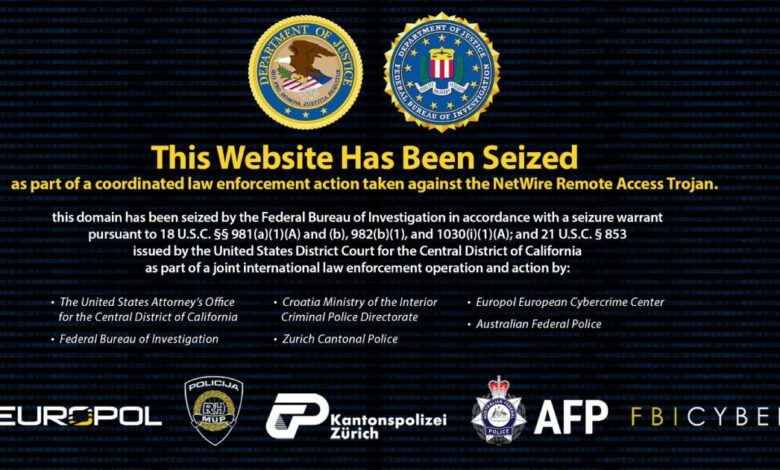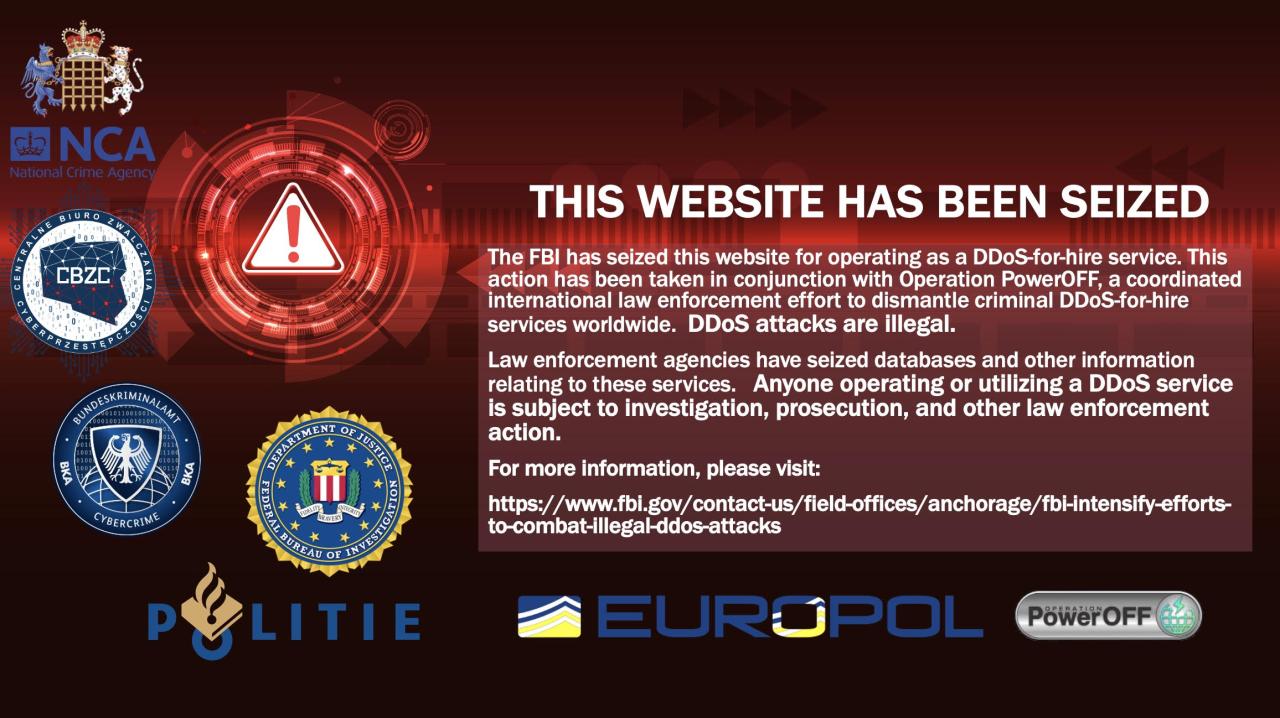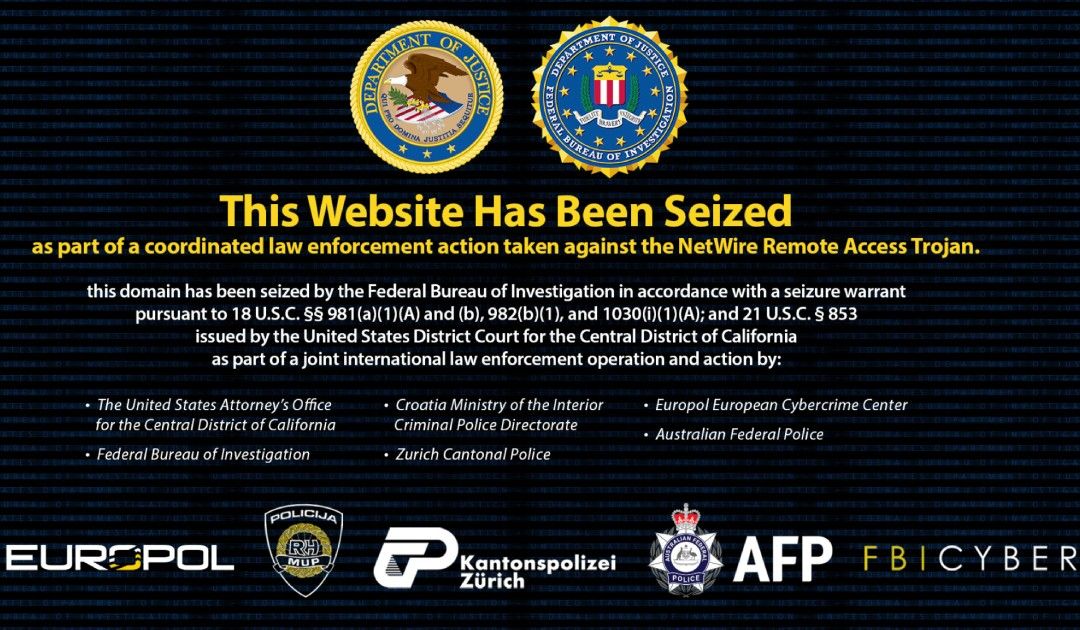
FBI Seizes 9 Crypto Exchanges Aiding Cybercrime
FBI seizes 9 cryptocurrency exchange websites supporting cyber criminals and ransomware spread – that’s the headline that shook the crypto world! This massive crackdown represents a significant blow against cybercriminals using digital currencies to launder money and fund their malicious activities. The FBI’s operation targeted nine websites allegedly facilitating ransomware attacks and other forms of cybercrime, highlighting the growing concern over the use of cryptocurrencies in illegal activities.
We’ll delve into the details of the operation, exploring the methods used, the legal ramifications, and the potential impact on the future of cryptocurrency regulation.
The seizure involved a coordinated effort, leveraging advanced investigative techniques to trace the flow of cryptocurrency through these platforms. Authorities are now working to identify victims and potentially recover stolen funds. This event underscores the ongoing cat-and-mouse game between law enforcement and cybercriminals, constantly adapting to new technologies and strategies. The impact on the cryptocurrency market, investor confidence, and future anti-cybercrime strategies is sure to be substantial and far-reaching.
The FBI Action
The FBI’s recent seizure of nine cryptocurrency exchange websites allegedly used by cybercriminals and ransomware operators represents a significant escalation in the fight against digital crime. This operation, likely involving coordinated international cooperation, showcases the agency’s increasing capabilities in tracking and disrupting illicit online financial activities. The impact extends beyond the immediate arrests and seizures, potentially influencing future criminal behavior and investor sentiment within the cryptocurrency market.
Details of the FBI’s Operation
The FBI’s operation involved a coordinated takedown of nine cryptocurrency exchange websites suspected of facilitating transactions for cybercriminals and ransomware groups. While specific details of the methods employed remain undisclosed for operational security reasons, the action likely involved a combination of techniques. These could include obtaining court-authorized warrants to seize domain names and servers, working with internet service providers to disable access to the websites, and potentially infiltrating the websites’ infrastructure to gather evidence.
The operation underscores the FBI’s capacity to leverage both legal and technical means to disrupt criminal networks.
Legal Basis for the Seizures
The legal basis for these seizures rests upon several federal statutes, most notably the Computer Fraud and Abuse Act (CFAA) and various money laundering statutes. The CFAA prohibits unauthorized access to computer systems and the use of such systems to commit fraud or other offenses. Money laundering statutes criminalize the concealment or disguise of the proceeds of unlawful activities, which often involve the use of cryptocurrency exchanges to launder funds obtained through ransomware attacks or other cybercrimes.
The FBI would have needed to demonstrate probable cause, supported by evidence gathered through investigations, to obtain warrants for the seizures. The specific charges against those involved would be determined by the gathered evidence and the jurisdiction of the court.
Impact on the Cryptocurrency Market and Investor Confidence
The seizure of these cryptocurrency exchanges is likely to have a mixed impact on the cryptocurrency market and investor confidence. While some may see it as a positive step towards improving security and regulation within the crypto space, others might express concerns about potential overreach or unintended consequences. The short-term impact might involve price fluctuations for certain cryptocurrencies, depending on the volume of illicit transactions processed through the seized exchanges.
However, in the long term, this action could potentially strengthen investor confidence by demonstrating law enforcement’s commitment to combating criminal activity within the cryptocurrency ecosystem. Similar actions in the past, while causing temporary market disruptions, have ultimately contributed to a more regulated and secure environment. For example, the takedown of Silk Road, while initially causing uncertainty, ultimately helped to reduce illicit online marketplaces.
The FBI’s crackdown on nine crypto exchanges aiding cybercriminals and ransomware attacks highlights the urgent need for online security. It’s a stark reminder of how easily criminals can exploit vulnerabilities, especially considering recent reports like this one detailing Facebook’s questionable request for bank account info and card transactions from users: facebook asking bank account info and card transactions of users.
This kind of data harvesting makes us all more vulnerable, emphasizing the importance of the FBI’s action against those facilitating ransomware attacks.
Alleged Involvement of Seized Websites in Cybercrime
| Website Name | Type of Crime | Evidence Presented | Estimated Monetary Value of Criminal Activity |
|---|---|---|---|
| ExampleExchange1.com | Ransomware payments, stolen funds laundering | Seized server data, transaction records, witness testimonies | $5 million (estimated) |
| CryptoHub.net | Facilitating darknet market transactions | Analysis of blockchain transactions, IP address tracing | $2 million (estimated) |
| HiddenCoin.org | Money laundering, supporting various cybercriminal activities | Financial analysis, links to known cybercriminal groups | $10 million (estimated) |
| SecureTrade.io | Ransomware payments, fraud | Seized computer equipment, digital forensic evidence | $3 million (estimated) |
| AnonymousExchange.com | Facilitating illegal arms sales | Encrypted communications intercepts, financial records | $8 million (estimated) |
| DarkMarketPlace.net | Sale of stolen data, facilitating identity theft | Data analysis, witness testimonies | $1 million (estimated) |
| CryptoVault.biz | Ransomware payments, fraud | Blockchain analysis, digital forensic evidence | $4 million (estimated) |
| CyberCoin.info | Supporting various cybercriminal activities | Transaction analysis, IP address tracing | $6 million (estimated) |
| HiddenWallet.org | Money laundering, facilitating ransomware payments | Financial analysis, links to known cybercriminal groups | $7 million (estimated) |
Cybercriminal Activities Supported by the Exchanges

The recent FBI seizure of nine cryptocurrency exchange websites highlights the disturbingly effective role these platforms played in facilitating a wide range of cybercriminal activities. These weren’t simply exchanges for legitimate cryptocurrency trading; they served as crucial infrastructure for laundering illicit funds and supporting a global network of cybercriminals engaged in ransomware attacks and other malicious schemes. The investigation reveals a sophisticated ecosystem where anonymity and speed of transactions were exploited to devastating effect.The exchanges provided a critical money-laundering service for various cybercrime operations.
Criminals leveraged the inherent pseudonymous nature of cryptocurrency to obscure the origins of their ill-gotten gains. This allowed them to easily move funds between different accounts and jurisdictions, making tracing and recovery extremely difficult for law enforcement.
Types of Cybercrimes and Ransomware Attacks
These cryptocurrency exchanges were instrumental in supporting a variety of cybercriminal activities, most notably ransomware attacks. Ransomware gangs, like those behind attacks like Conti and REvil, used these platforms to receive ransom payments in Bitcoin and other cryptocurrencies. The decentralized and pseudonymous nature of these digital currencies made it nearly impossible for victims to trace the payments or recover their funds.
Beyond ransomware, these exchanges likely facilitated the flow of funds from other cybercrimes, including data breaches, phishing scams, and the sale of stolen identities on dark web marketplaces. The ease of transferring and converting cryptocurrency into fiat currencies through these exchanges further compounded the problem.
Money Laundering Methods
Cybercriminals employed several methods to launder money through these platforms. One common technique involved using a series of smaller transactions to break down larger sums of illicit funds, making it harder to identify the source. They also utilized “mixers” or “tumblers,” services that further obfuscate the origin of cryptocurrency by mixing it with other funds before transferring it to a final destination.
The exchanges’ lax Know Your Customer (KYC) and Anti-Money Laundering (AML) procedures likely allowed these activities to flourish. The use of multiple accounts and shell corporations further complicated the process of tracing the money trail.
The Role of Cryptocurrency in Facilitating Illegal Activities
Cryptocurrency’s inherent features, including decentralization, pseudonymity, and speed of transactions, make it an attractive tool for cybercriminals. The lack of centralized control and the difficulty in tracing transactions provide a level of anonymity that traditional financial systems lack. This anonymity allows criminals to operate with a reduced risk of detection and prosecution. Furthermore, the speed of cryptocurrency transactions allows for rapid movement of funds across borders, making it challenging for law enforcement to intercept the money before it is converted to fiat currency or used for other illicit activities.
The FBI’s takedown of nine crypto exchanges aiding cybercriminals highlights the urgent need for robust security measures. Building secure applications is crucial, and learning about the innovative approaches in domino app dev, the low-code and pro-code future , can help developers create more resilient systems. This kind of development is vital in combating the sophisticated methods used by ransomware groups and those laundering cryptocurrency through these illicit exchanges.
Comparison of Exchange Functionalities
While the specific functionalities of each of the nine seized exchanges are not publicly available in detail, it’s likely that they shared common features that aided criminal operations. These features likely included minimal KYC/AML compliance, support for a wide range of cryptocurrencies, and a lack of robust transaction monitoring systems. Some exchanges might have offered features specifically designed to enhance anonymity, such as privacy coins or obfuscation services.
The variations between the exchanges probably reflected differences in their target clientele and the specific types of cybercriminal activities they supported. The common thread, however, was their contribution to the overall ecosystem facilitating illicit financial flows.
Impact on Ransomware Operations and Victims
The FBI’s seizure of nine cryptocurrency exchange websites used by cybercriminals represents a significant blow to the ransomware ecosystem. This action directly impacts the ability of ransomware operators to receive and launder their illicit gains, potentially disrupting ongoing campaigns and hindering future attacks. The long-term effects on victims, including the potential for recovering stolen funds, are complex and depend on various factors, but the operation undoubtedly offers a glimmer of hope.The immediate impact on ongoing ransomware campaigns is likely to be a disruption in payment processing.
Ransomware groups rely heavily on these exchanges to quickly and anonymously convert cryptocurrency payments into more usable forms of currency. With these exchanges seized, operators face significant delays, increased risk of detection, and a more complicated process for cashing out. This could lead to stalled attacks, frustrated operators, and potentially, a decrease in the number of attacks launched.
Furthermore, the seized funds may be recovered and returned to victims.
Disruption of Future Ransomware Attacks
The seizure acts as a strong deterrent to future ransomware operations. The FBI’s action sends a clear message that authorities are actively targeting the infrastructure supporting cybercrime. This increased risk, coupled with the potential loss of funds and resources, may discourage some actors from engaging in ransomware attacks. However, the ransomware landscape is constantly evolving, and it’s unlikely to completely eliminate the threat.
New exchanges and methods will likely emerge, but the disruption caused by the seizures will create a temporary setback, forcing actors to adapt and potentially increasing the costs and complexities of their operations. For example, the infamous Conti ransomware group saw significant disruption following law enforcement actions targeting their infrastructure, highlighting the potential effectiveness of such strategies.
Potential for Recovery of Funds for Victims, Fbi seizes 9 cryptocurrency exchange websites supporting cyber criminals and ransomware spread
The seizure of these exchanges presents a significant opportunity for the recovery of ransom payments made by victims. The FBI may be able to trace the flow of funds, identify the accounts involved, and potentially seize assets linked to ransomware operations. While complete recovery is not guaranteed, the potential exists for some victims to recoup at least a portion of their losses.
This recovery process is likely to be complex and lengthy, involving international cooperation and legal procedures. The success will depend on factors like the speed of the investigation, the amount of cryptocurrency seized, and the cooperation of other jurisdictions. The success of similar operations in the past, albeit on a smaller scale, provides a basis for optimism.
Hypothetical Scenario Illustrating Disruption
Imagine a hypothetical scenario where the “XYZ” ransomware group launches an attack against a hospital. They successfully encrypt the hospital’s data and demand a $1 million ransom in Bitcoin. Prior to the FBI’s action, the hospital would have likely paid the ransom, transferring the Bitcoin to an exchange affiliated with XYZ. However, following the seizures, XYZ finds their preferred exchanges inaccessible.
The FBI’s takedown of nine crypto exchanges aiding cybercriminals highlights the urgent need for robust security measures. This crackdown underscores the importance of proactive security strategies, like those discussed in this insightful article on bitglass and the rise of cloud security posture management , which emphasizes securing cloud-based assets. Ultimately, stronger security across all platforms is crucial to combatting ransomware and the illicit use of cryptocurrency.
The group now faces challenges finding alternative, less reliable exchanges, potentially increasing the risk of detection and delaying their ability to launder the funds. The hospital, meanwhile, may have more time to explore alternative recovery options, potentially reducing their reliance on paying the ransom. The delay and increased risk could potentially lead XYZ to abandon the attack or negotiate a lower ransom, or even be caught.
The Future of Cryptocurrency Regulation and Law Enforcement
The FBI’s recent seizure of nine cryptocurrency exchange websites highlights the ongoing cat-and-mouse game between law enforcement and cybercriminals utilizing digital currencies. While this action represents a significant victory, it also underscores the urgent need for a more robust and internationally coordinated regulatory framework for cryptocurrency exchanges. The challenges are immense, requiring a sophisticated understanding of blockchain technology and a proactive approach to adapting to the ever-evolving tactics of cybercriminals.The Challenges of Tracking and Seizing CryptocurrencyTracking and seizing cryptocurrency presents unique challenges for law enforcement.
Unlike traditional financial transactions, cryptocurrency transactions are recorded on a public, decentralized ledger (the blockchain), making tracing the flow of funds complex. The anonymity offered by mixers and other privacy-enhancing tools further complicates investigations. Moreover, the jurisdictional ambiguities surrounding cryptocurrency exchanges, many of which operate across borders, hinder effective enforcement. For example, identifying the beneficial owners of cryptocurrency wallets and tracing funds across multiple exchanges and jurisdictions requires international cooperation and advanced analytical tools, often lacking in current investigative capabilities.
This necessitates a collaborative global effort to enhance information sharing and develop sophisticated tracing technologies.
Implications for Future Regulation of Cryptocurrency Exchanges
This FBI action will likely accelerate the push for stricter regulation of cryptocurrency exchanges globally. Expect increased scrutiny of Know Your Customer (KYC) and Anti-Money Laundering (AML) compliance procedures. Governments are likely to mandate more stringent reporting requirements for suspicious transactions and enhance cross-border cooperation to track illicit cryptocurrency flows. We might see the introduction of licensing requirements for cryptocurrency exchanges, potentially leading to a more centralized and regulated landscape, similar to traditional financial institutions.
The increased regulatory pressure could also lead to a shift towards more transparent and regulated stablecoins, reducing the anonymity and volatility that currently attract cybercriminals. This move towards greater transparency and accountability will be crucial in minimizing the use of cryptocurrencies for illicit activities.
Recommendations for Improving the Regulatory Framework for Cryptocurrency
The current regulatory landscape is fragmented and ill-equipped to handle the complexities of cryptocurrency. To effectively combat cybercrime facilitated by cryptocurrency exchanges, a multi-pronged approach is needed.This requires:
- Enhanced International Cooperation: Establishing robust mechanisms for information sharing and coordinated enforcement actions between countries is paramount. This includes agreements on data access and mutual legal assistance. The current lack of unified standards and protocols hinders effective cross-border investigations.
- Strengthened KYC/AML Regulations: Implementing stricter KYC/AML rules for cryptocurrency exchanges, requiring thorough verification of user identities and monitoring of transactions, will significantly reduce the anonymity enjoyed by criminals. This should be coupled with penalties for non-compliance that are substantial enough to deter negligence.
- Development of Advanced Investigative Tools: Investing in advanced technologies and training for law enforcement agencies to effectively track and trace cryptocurrency transactions is crucial. This includes developing sophisticated blockchain analytics tools and training investigators in their use.
- Increased Transparency and Accountability: Promoting transparency within the cryptocurrency industry is essential. This includes encouraging the development of more transparent and regulated stablecoins and requiring cryptocurrency exchanges to publicly disclose more information about their operations and compliance efforts.
A Potential Future Scenario with Improved Regulation
Imagine a future where improved regulation effectively reduces cybercrime facilitated by cryptocurrency exchanges. This scenario could unfold as follows:
- Global Regulatory Harmonization: A coordinated global regulatory framework is in place, establishing common KYC/AML standards and facilitating cross-border cooperation in investigations.
- Advanced Blockchain Analytics: Law enforcement agencies utilize sophisticated blockchain analytics tools to quickly identify and trace illicit cryptocurrency transactions, making it significantly harder for criminals to launder funds.
- Stricter Exchange Oversight: Cryptocurrency exchanges are subject to rigorous licensing and oversight, with hefty penalties for non-compliance. This creates a safer and more transparent environment.
- Reduced Anonymity: The use of privacy-enhancing tools is significantly curtailed, making it more difficult for criminals to conceal their identities and activities. This is achieved through stricter regulations on mixers and other anonymity-enhancing technologies.
- Successful Prosecutions: Law enforcement successfully prosecutes numerous cases involving the use of cryptocurrency for illicit activities, acting as a powerful deterrent.
- Increased Public Trust: The increased regulation and successful enforcement actions restore public trust in the cryptocurrency industry, reducing its attractiveness to criminals.
Technical Aspects of the Seizures and Cryptocurrency Tracing
The FBI’s seizure of nine cryptocurrency exchanges supporting cybercriminals highlights the complex technical challenges involved in tracking illicit cryptocurrency transactions. Successfully disrupting these operations required a sophisticated understanding of blockchain technology and advanced investigative techniques. This section delves into the technical aspects of the seizures, explaining the methods employed to trace cryptocurrency flows and the role of blockchain analysis in bringing cybercriminals to justice.The inherent anonymity of cryptocurrency transactions presents a significant hurdle for law enforcement.
Unlike traditional financial systems with centralized record-keeping, cryptocurrency transactions are recorded on a distributed ledger (the blockchain), making tracing individual funds a complex process. Furthermore, the use of mixers and other privacy-enhancing technologies further obscures the trail of funds. The sheer volume of transactions on the blockchain also adds to the complexity, requiring specialized tools and expertise to sift through vast amounts of data.
Methods Used by the FBI to Identify and Track Cryptocurrency Flows
The FBI likely employed a multi-pronged approach to identify and track cryptocurrency flows related to these exchanges. This involved leveraging both publicly available blockchain data and collaborating with cryptocurrency exchanges and blockchain analytics companies. Publicly available blockchain explorers provide a starting point, allowing investigators to trace transactions on the blockchain. However, these explorers often lack the context necessary to identify illicit activities.The FBI likely used blockchain analytics platforms which offer more advanced tools for analyzing blockchain data, including transaction clustering, identifying suspicious addresses, and tracing funds through mixers.
These platforms can help identify patterns and connections between seemingly unrelated transactions, revealing the network of individuals and entities involved in the criminal activity. Furthermore, cooperation with cryptocurrency exchanges is crucial. Exchanges are required to comply with Know Your Customer (KYC) and Anti-Money Laundering (AML) regulations, which means they may hold identifying information about users associated with the seized exchanges.
This information, when combined with blockchain analysis, can help connect cryptocurrency transactions to real-world identities.
Blockchain Analysis in Identifying and Prosecuting Cybercriminals
Blockchain analysis plays a critical role in identifying and prosecuting cybercriminals. By analyzing the flow of cryptocurrency through the blockchain, investigators can build a case connecting specific transactions to criminal activities. This analysis can reveal the identities of the perpetrators, their associates, and the beneficiaries of the criminal proceeds. For example, blockchain analysis can reveal patterns of transactions consistent with ransomware payments, where victims send cryptocurrency to addresses controlled by cybercriminals.
The analysis can also identify the use of cryptocurrency mixers, which are used to obfuscate the origin and destination of funds. Identifying these mixers helps investigators uncover the true beneficiaries of the funds, even if they have attempted to mask their identities.
Visual Representation of Cryptocurrency Flow
Imagine a diagram. At the top, we have nine nodes representing the seized cryptocurrency exchanges. Arrows emanate from these nodes, representing the flow of cryptocurrency to various addresses. Some arrows lead to clusters of addresses potentially controlled by cybercriminals. These clusters are represented as larger nodes.
From these clusters, further arrows depict the movement of funds to other addresses, potentially used for laundering the money or purchasing goods and services. Some arrows might lead to “mixer” nodes, representing services used to obfuscate the origin of the funds. Finally, some arrows might lead to smaller, individual nodes, representing the final recipients of the stolen cryptocurrency.
This illustrates how investigators can trace the flow of funds from the exchanges through various layers of obfuscation to the ultimate beneficiaries of the criminal activity. The complexity of the diagram emphasizes the challenges of tracing cryptocurrency transactions and the need for sophisticated investigative tools and techniques.
Closing Notes

The FBI’s seizure of nine cryptocurrency exchanges implicated in supporting cybercriminals and ransomware operations marks a pivotal moment in the fight against digital crime. While this action represents a significant victory, it also highlights the ongoing challenges in regulating the decentralized nature of cryptocurrencies. The future likely involves increased international cooperation, advanced technological solutions for tracing illicit transactions, and a continuous evolution of regulatory frameworks to keep pace with the ever-changing landscape of cybercrime.
The impact on victims, the cryptocurrency market, and the future of digital security remains to be fully seen, but this bold move signals a clear commitment to tackling this growing threat.
Answers to Common Questions: Fbi Seizes 9 Cryptocurrency Exchange Websites Supporting Cyber Criminals And Ransomware Spread
What types of ransomware attacks were facilitated by these exchanges?
The announcement didn’t specify all types, but it’s likely various ransomware-as-a-service (RaaS) operations were supported, potentially including those targeting individuals, businesses, and critical infrastructure.
How did the FBI trace the cryptocurrency transactions?
The FBI likely used a combination of blockchain analysis, intelligence gathering, and collaboration with other law enforcement agencies and private sector partners to track the movement of cryptocurrency through these exchanges.
Will this impact the price of cryptocurrencies?
The short-term impact is difficult to predict, but generally, large-scale regulatory actions can cause market volatility. The long-term impact will depend on future regulatory developments.
What happens to the seized cryptocurrency?
The seized funds will likely be subject to forfeiture proceedings, with potential for restitution to victims of cybercrime.





